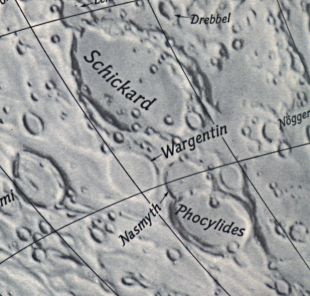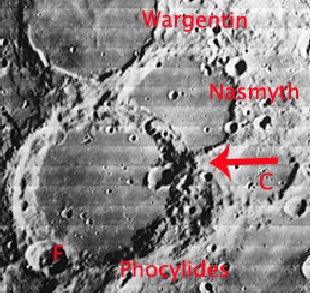

Observer: Tony Donnangelo Date/time of observation: 2004/05/02 23:10 U.T. Site location: Hummelstown RD 3, PA, USA (40.26° N., 76.75° W.) Site elevation: 479 feet (146 meters) Site classification: Suburban Moons age: 13d 09:48, 95.0% illuminated Librations: 119° PA; -3° 27in Lat., -6° 00 in Long. Instrument: Takahashi FS-102 f/8 Magnification: 117x Object: Phocylides (walled plain) Dimensions: 117 x 117 Km. (69 x 69 Mi.) Height: 0; Height/Width ratio: 0.0246 Lunar ray coordinates: 55.0° W, 52.0° S Rükl chart #: 70
The sky was very clear at sunset. Weather maps indicated a heavy cloud system moving in very shortly. I began observing the moon 1 hour 23 minutes before the end of Civil Twilight, being still very bright out. Within seconds, the sky was approximately 95% clouded. I was reduced to observing through a few small holes lasting only a couple seconds.
Approximately three years ago, I observed a possible ray in Phocylides if observed at an earlier hour. I calculated dates for reoccurrences. When next observed, a thin ray across a completely shadowed floor definitely didnt materialize. Both observations were after astronomical twilight. I quit considering its possibility. By shear chance, I saw it soon after sunset. Beyond question, it now definitely was an easily visible ray. Re-observing it on yet another date after twilight, it was just a patch of light. I was determined to observe it again right after sunset. I calculated the day using Harry Jamiesons The Lunar Observers Toolkit. This was it! After all this time, I had to make the most of it.
Lo and behold, as soon as I set up, the ray was already occurring. It might have been possible to observe it at an even earlier time. Within 10 seconds, the moon was completely shrouded by heavy clouds.
The ray was a very thin, long shaft of light extending to the western interior wall. Next observed at 23:29 U.T., it was slightly broader. Nasmyths floor was fully illuminated. Phocylides rim was also illuminated with its floor totally shadowed. At 00:51 U.T., the ray was very wide and cone shaped. The shadow of a peak was cast through the ray and half way up the completely illuminated interior western wall. It no longer looked like a ray. Wargentins floor was illuminated except for the eastern edge below the wall. I was satisfied and saw no further holes approaching. I ended my observing session.
Observing this short-lived thin beam of light may prove to be a real challenge, requiring very precise circumstances not occurring bimonthly. It took me over two years to verify my observation. I would like to see reports from other observers.
The Initial Predictions, Using Data in Original Reporting
Site Longitude = +76.750
Site Latitude = +40.260
Reproducing Lighting For: 2004/5/2 at 23:10 U.T.
Desired Solar Altitude = +9.082(Rising), Azimuth = +78.141
Feature = Phocylides
Feature Longitude: = -55.000
Feature Latitude: = -52.000
Average Co-longitude = 69.856
Moon's Altitude Restricted = N
In the Time column, D=Daylight, T=Twilight
---- Moon's ---- -- Earth's --
Topocentric Topocentric -------- Sun's --------
UT Date Time Alt° Semi-Diam'' Long° Lat° Colong° Lat° Azim°
2004/05/02 23:10D +15.872 980.12 -4.715 -2.426 069.898 +0.031 +78.141
Crater Description:
Description of Phocylides from Virtual Moon Atlas: Formed during the Nectarian Period, from -3.92 to -3.85 billion years. Circular formation forming an interesting trio with Wargentin and Nasmyth. A few steep slopes overlapping Nasmyth to the north supporting Phocylides C & J to the north-east and Phocylides J to the south-west. A few high walls ridden by Phocylides F to the south. A very flat floor filled with lava. Numerous craterlets with a large one to the north-east. Break connecting Phocylides F to the center.

